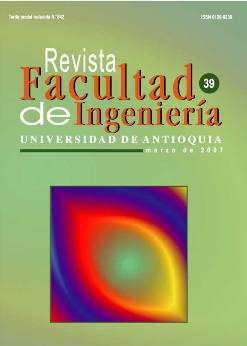Síntesis de nanopartículas de SnO2 y su uso en la conformación de varistores
DOI:
https://doi.org/10.17533/udea.redin.20188Palabras clave:
nanopartículas, SnO2, polvos cerámicos, varistoresResumen
En este trabajo se utilizaron los métodos de coprecipitación y precursor polimérico para obtener nanopartículas de SnO2 dopado con TiO2, CoO, Nb2O3 y Al2O3. Los polvos cerámicos obtenidos fueron caracterizados utilizando difracción de rayos X (DRX), y microscopía electrónica de barrido (MEB). Posteriormente se determinó su sinterabilidad a través de estudios de dilatometría. Muestras sinterizadas del sistema de interés fueron caracterizadas eléctrica y microestructuralmente para determinar su uso como varistores.
Descargas
Citas
J. Klabunde. Nanoscale materials in chemistry. New York. John Wiley & Sons Ind. 2001. pp. 85-120.
K. J. Klabunde, J. V. Stark, O Koper, C Mohs, D. G. Park, S. Decker, Y. Jiang, I. Lagadic, D. Zhang, “Study of nanoscale powder preparation”. J. Phys. Chem., Vol 100. 1996. pp. 12142-12153.
K. J. Klabuncfe, C. Mohs. Chemistry of advanced materials. NewYork. L. V.Interrante, M. J. Hampden-Smith (editors). 1998. Chap. 7. pp. 317-358
J. Herring. “Effect of change of scale on sintering phenomena”. J. Appl. Phys. Vol. 21. 1950. pp. 301-330.
F. F. Lange. “Powder processing science and technology for increased reliability”. J. Am. Ceram. Soc. Vol 72. 1989. pp. 3-15.
W. Luán, L. Gao, J. Guo. “Study on drying stage of nanoscale powder preparation”. Nanostruct. Mater. Vol. 10. 1998. pp. 1119-1125.
J. Moulson, J. M. Herbert. Electroceramics. John Wiley & Sons. Inc. second edition. 2003. pp. 135 - 240.
J. M. Jorzebsk, J. P. Marton. “Physical properties of SnO2 materials. II Electrical properties”. J. Electro-chem. Soc. Vol. 129. 1976. pp. 299C-310C.
M. A. Ponce. Comportamiento eléctrico de sensores de gases de SnO2, Tesis doctoral Universidad Nacional de Mar del Plata-INTEMA. 2005.
L. Hozer. “Semiconductor ceramics: grain boundary effects”. Ellis Horwood series in Physics and its ap-plications. 1994. pp. 44-98.
S. A. Pianaro, P. R. Bueno, E. Longo, J. A. Varela. “A new SnO2 based varistor system”. J. Mater. Sci. Lett. Vol. 14. 1995. pp. 692-694.
J. Shen, R. D. Cortright, Y. Chen, J. A. Dumisec. “Microcalorimetric and infrared spectroscopic studies of Al2O3 modified by tin oxides”. Catal. Lett. Vol. 26. 1984. pp. 247-257.
T. Tagawa, S. Kataoka, T. Hattori, Y. Murakami. “Supported tin dioxide catalysts for the oxidative dehydrogenation of ethylbenzene”. Appl. Catal. Vol. 4. 1982. pp.1-4.
N. Sergent, P. Gélin, L. Périer-Cambry, H. Praliaud, G. Thomas. “Preparation and characterization of high surface area stannic oxides: structural, textural and semiconducting properties”. Sens. Actuators B. Vol. 84. 2002. pp. 176-1888.
A. C. Bose, D. Kalpana, P. Thangadurar, S, Ramasamy. “Synthesis and characterization of nanocrystalline SnO2 and fabrication of lithium cell using nano-SnCY”. J. Pow. Source. Vol. 107. 2002. pp. 138-141.
N. S. Baik, G. Sakai, N Miura, N. Yamazoe. “Preparation of stabilized nanosized tin oxide particles by hydrothermal treatment”. J. Am. Ceram. Soc. Vol. 83. 2000. pp. 2983-2987.
Z. Zhang, L Gao. “Synthesis and characterization of nanocrystalline tin oxide by sol-gel method”. J. Solid State Chem. Vol. 177. 2004. pp.1425-1430.
Z. Deng, C. Wang, Y. U. “New hydrolytic process for producing zirconium dioxide, tin dioxide and titanium dioxide nanoparticles”. J. Am. Ceram. Soc. Vol. 85. 2002. pp. 2837-2839.
E. R. Leite, J. W. Gomes, M. M. Oliveira, E. J, H. Lee, E. Longo, J. A. Varela, C. A. Paskocimas, T. M. Boschi, F. Lanciotti, P. S. Pisan, P. C. Soares. “Synthesis of SnO2 nanoribbons by a carbothermal reduction process”. J. Nanosci. Nanotechn. Vol. 2. 2002. pp. 125-128.
E. R. Leite, A. P. Maciel, I. T. Weber, P. N. L. Filho, E. Longo, C, O. P. Santos, A. V. C. Andrade, C. A. Pakos-cimas, Y. Manietle, W. H. Schreiner. “Development of metal oxide nanoparticles with high stability against particle growth using a metastable solid solution”. Adv. Mater. Vol. 14. 2002. pp. 905-908.
C. Ararat, J. A. Varela, J. E. Rodríguez Páez. “Uso de métodos químicos para obtener polvos cerámicos del sistema (Sn, Ti)O2”. Bol, Soc. Esp. Ceram. Vol. 44. 2005. pp. 215-222.
C. Ararat, J. A. Várela, J. E. Rodríguez-Páez. “Efecto del método de síntesis sobre la sinterabilidad de los polvos cerámicos de (Sn, Ti)O2”. Revista de la Academia Colombiana de Ciencias Exactas, Físicas y Naturales, Vol. 29. 2005. pp. 271-281.
Descargas
Publicado
Cómo citar
Número
Sección
Licencia
Los artículos disponibles en la Revista Facultad de Ingeniería, Universidad de Antioquia están bajo la licencia Creative Commons Attribution BY-NC-SA 4.0.
Eres libre de:
Compartir — copiar y redistribuir el material en cualquier medio o formato
Adaptar : remezclar, transformar y construir sobre el material.
Bajo los siguientes términos:
Reconocimiento : debe otorgar el crédito correspondiente , proporcionar un enlace a la licencia e indicar si se realizaron cambios . Puede hacerlo de cualquier manera razonable, pero no de ninguna manera que sugiera que el licenciante lo respalda a usted o su uso.
No comercial : no puede utilizar el material con fines comerciales .
Compartir igual : si remezcla, transforma o construye a partir del material, debe distribuir sus contribuciones bajo la misma licencia que el original.
El material publicado por la revista puede ser distribuido, copiado y exhibido por terceros si se dan los respectivos créditos a la revista, sin ningún costo. No se puede obtener ningún beneficio comercial y las obras derivadas tienen que estar bajo los mismos términos de licencia que el trabajo original.










 Twitter
Twitter